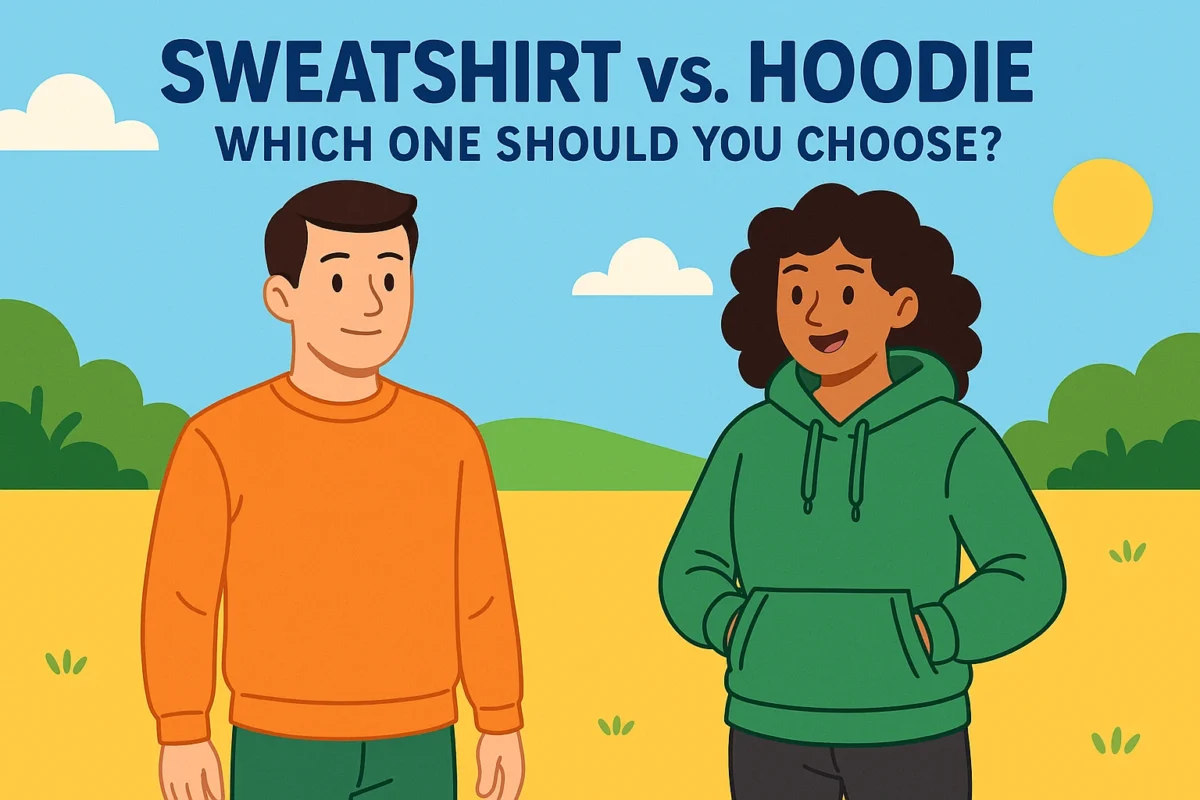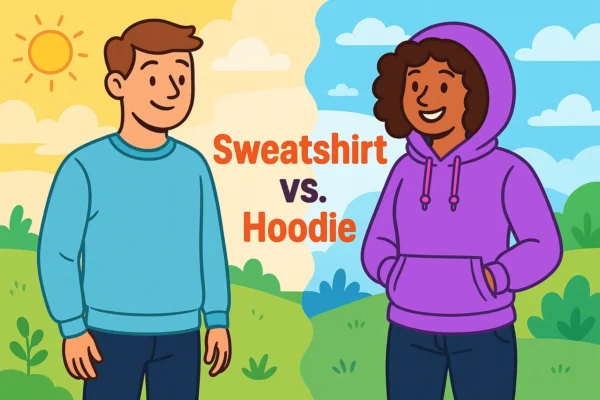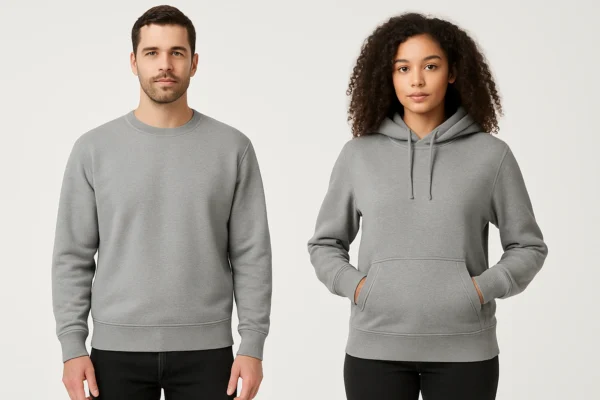Sweatshirt vs. Hoodie: Which One Should You Choose?
When it comes to casual, comfortable fashion, sweatshirts and hoodies are timeless favorites. Both are warm, versatile, and perfect for everything from lounging at home to running errands or heading to the gym. While they share many similarities—like soft materials and relaxed fits—their design differences can affect how you wear and style them.
So, which one is better for your lifestyle: a sweatshirt or a hoodie?
In this article, we’ll explore the key differences between sweatshirts and hoodies, including their features, materials, styling options, and ideal use cases. Whether you’re shopping for comfort or building a custom clothing line, this guide will help you choose the right option that fits both your needs and your look.
Sweatshirt vs. Hoodie: A Quick Overview
Sweatshirts and hoodies are two of the most reliable pieces in any casual wardrobe. While they share a lot of similarities—soft fabrics, long sleeves, and all-day comfort—their differences lie in function and form. From layering options to streetwear staples, each offers unique benefits depending on your personal style and needs.
What is a Sweatshirt?
A sweatshirt is a pullover-style top made from thick, soft materials like cotton, fleece, or a blend of both. Originally developed in the 1920s as athletic wear, sweatshirts were designed to absorb sweat during workouts—hence the name. Over time, they evolved into everyday casual wear, known for their simplicity, warmth, and versatility.
Read More: Why Oversized Sweatshirts are a Wardrobe Essential?
Key features of a sweatshirt:
- Crewneck or round neckline: The collarless, smooth neckline offers a clean look.
- No hood: Unlike hoodies, sweatshirts don’t have a hood, making them easier to layer under jackets or over collared shirts.
- Pullover design: Most sweatshirts are worn over the head with no zippers or fasteners.
Best use cases:
- Ideal for layering under coats or over shirts.
- Suitable for semi-casual styling, like pairing with jeans or chinos.
- Perfect canvas for embroidery or subtle printed designs due to the flat, uninterrupted front.
What is a Hoodie?
A hoodie is a type of sweatshirt that comes with a hood—hence the name. Originally worn as utilitarian outerwear by workers in cold warehouses, the hoodie gained popularity through sports culture and eventually became a mainstay in streetwear and casual fashion.
Key features of a hoodie:
- Attached hood with drawstrings: Provides adjustable coverage and warmth in colder or windy weather.
- Kangaroo pocket: Most hoodies have a large front pocket for convenience and added warmth.
- Pullover or zip-up styles: Hoodies come in both classic pullover forms and zip-up versions for easy layering.
Best use cases:
- Perfect for lounging or working from home.
- Great for outdoor wear, offering extra coverage during chilly days.
- A staple in street style, often paired with joggers or jeans.
- Ideal for warmth and comfort in colder climates.
Key Differences Between Sweatshirts and Hoodies
Though sweatshirts and hoodies may seem similar at first glance, a few design elements create distinct differences in how and when each is best worn. From their structural features to overall styling, understanding what sets them apart can help you make a smarter wardrobe or product decision.
Hood vs. No Hood
Hoodies come with an attached hood—often adjustable with drawstrings—making them ideal for outdoor use, chilly days, or when you want a bit more coverage from wind or light rain.
Sweatshirts, by contrast, have no hood, giving them a cleaner silhouette that layers more easily under jackets or coats.
If you’re dressing for comfort and flexibility, sweatshirts are great indoors or in milder weather, while hoodies shine in colder or unpredictable conditions.
Pockets and Utility
Hoodies usually feature a large kangaroo pocket in the front or sometimes zippered or side pockets. These provide both practicality and a relaxed, casual look.
Sweatshirts typically lack a pocket altogether, though some modern designs may include discreet side pockets.
If you need somewhere to stash small items like your phone or just want a cozy spot for your hands, a hoodie offers more utility. On the other hand, the absence of pockets gives sweatshirts a sleeker, more refined appearance—ideal for semi-casual or work-appropriate outfits.
Styling and Versatility
Sweatshirts are a go-to for minimalist and polished looks. They pair well with collared shirts, trousers, or layered under a blazer for a casual office setting.
Hoodies, meanwhile, are synonymous with laid-back streetwear. Their casual nature makes them perfect for off-duty looks, lounging, or pairing with joggers and sneakers.
Depending on your style goals, each garment serves a different aesthetic purpose—clean and refined or sporty and relaxed.
Warmth and Functionality
Thanks to the hood and often thicker material, hoodies tend to provide better overall warmth and protection. They’re great for colder days, layering over t-shirts, or even replacing a light jacket.
Sweatshirts, while still cozy, generally offer moderate warmth and are better suited to layering under coats or wearing in transitional weather.
If warmth is your top priority, hoodies have the edge—but for layering and versatility, sweatshirts often win out.
Understanding Hoodie & Sweatshirt Materials for Every Season
When deciding between a sweatshirt and a hoodie, the material can be just as important as the style. Fabric influences everything—how warm it feels, how breathable it is, how well it handles wear and tear, and how your design prints or embroiders onto it. Let’s break down the most popular materials and when they work best.
Read More: How to Choose the Right Hoodie Fabric
Cotton
Cotton is one of the most widely used materials for both sweatshirts and hoodies—and for good reason. It’s soft, breathable, and feels gentle on the skin, making it perfect for all-day wear.
Cotton also works exceptionally well for printing, especially direct-to-garment (DTG), allowing for crisp designs and vivid colors.
Best for: Everyday comfort, loungewear, and styles meant for direct printing.
Polyester
Polyester is a synthetic fabric known for its durability and performance features. Unlike cotton, it resists wrinkles and shrinkage, making it ideal for people on the go. Its moisture-wicking capabilities make it especially useful in activewear or for outdoor use where sweat and weather can be a factor.
Best for: Sportswear, travel gear, and garments that need to hold up under frequent use.
Cotton-Polyester Blends
Blends of cotton and polyester combine the best of both worlds: the softness and breathability of cotton with the strength and low-maintenance care of polyester. These blends tend to hold their shape better after washing and offer moderate moisture control.
Best for: Year-round wear, casual pieces, and customers who want balanced comfort and durability.
Fleece & French Terry
Fleece is a go-to fabric for winter-ready pieces. It has a brushed interior that feels plush and insulating, ideal for cozy hoodies designed for cold weather.
In contrast, French terry offers a lighter feel with a soft exterior and looped interior, providing excellent breathability and moisture absorption—making it an ideal choice for sweatshirts or for layering during in-between seasons like spring and fall.
Fleece is best for: Cold climates, outdoor wear, and cozy loungewear.
French terry is best for: Lightweight sweatshirts, spring/autumn pieces, and active casual looks.
Choosing Between Sweatshirts and Hoodies: What Really Fits Your Style
While sweatshirts and hoodies share comfort and casual appeal, choosing the right one depends on your specific needs, personal style, and target audience. Each option serves a slightly different purpose, whether you’re dressing for function or fashion.
Choose a Sweatshirt If…
- You want a minimalist or semi-formal look: Sweatshirts offer a clean, hoodless silhouette that pairs well with collared shirts or structured outerwear. They’re often favored in settings where a slightly more refined or understated style is appropriate.
- You’re planning to layer under jackets or wear it to work: Because they lack a bulky hood, sweatshirts fit more smoothly under coats or blazers, making them ideal for colder months or casual office environments.
- Your target audience values timeless, clean styles: If you’re selling apparel, sweatshirts are a safe bet for shoppers who prefer classic, neutral designs over trend-heavy options. They’re often favored across a broader age range.
Choose a Hoodie If…
- You prioritize comfort, warmth, and utility: With built-in hoods and kangaroo pockets, hoodies offer extra coverage and convenience. They’re perfect for relaxed days, travel, or unpredictable weather.
- You’re targeting a younger, streetwear-oriented audience: Hoodies are a cornerstone of streetwear and youth fashion. They’re more likely to appeal to Gen Z and millennials who value expressive, laid-back styles.
- You want to offer bold, high-contrast prints or zippers: The design surface of a hoodie—especially pullover or zip-up styles—gives more room for large graphics, text prints, or logos.
How to Care for Your Sweatshirts and Hoodies: Tips for Long-Lasting Wear
Taking good care of your sweatshirts and hoodies helps keep them looking great and lasting through many wears. With a few thoughtful habits, you can protect their fabric, colors, and fit season after season.
General Maintenance
- Turn garments inside out and use cold water: Washing your sweatshirt or hoodie inside out shields the surface from friction, helping prevent fading and wear. Cold water is gentler on fabrics, preserving the colors and reducing any risk of shrinking.
- Steer clear of bleach and high temperatures: Harsh chemicals like bleach can weaken fibers and cause color fading. Similarly, drying or washing in very hot water can cause shrinkage and may harm any prints or embroidery on your garment. Instead, choose mild detergents and let your items air dry when possible.
- Fold clothes instead of hanging: Hanging heavier garments like sweatshirts or hoodies can stretch out the shoulders and neckline over time. To keep their shape intact, fold and store them flat.
Special Tips for Hoodies
- Secure drawstrings before washing: To avoid your hoodie’s drawstrings getting tangled or caught inside the washing machine, tie them together or tuck them safely before tossing it in the wash.
- Close zippers fully: Always zip up hoodies fully before washing to avoid the zipper getting caught on other clothes or inside the machine, which can cause damage to both the zipper and surrounding fabrics.
Sweatshirt vs. Hoodie: Which One Matches Your Lifestyle?
Deciding whether to go for a sweatshirt or a hoodie really depends on your daily habits, fashion preferences, and what you need from your clothing.
Hoodies stand out when you’re after added coziness, warmth, and handy details such as a hood and pockets—ideal for casual hangouts, outdoor adventures, or embracing a relaxed streetwear vibe.
Sweatshirts, on the other hand, offer a cleaner, more polished appearance that works well for layering, smart-casual settings, and those who prefer minimalist designs without the bulk of a hood.
Neither is objectively better—it’s all about what fits your daily routine, climate, and aesthetic preferences. Don’t be afraid to experiment with different materials, fits, and designs to find the perfect balance between style and function.









